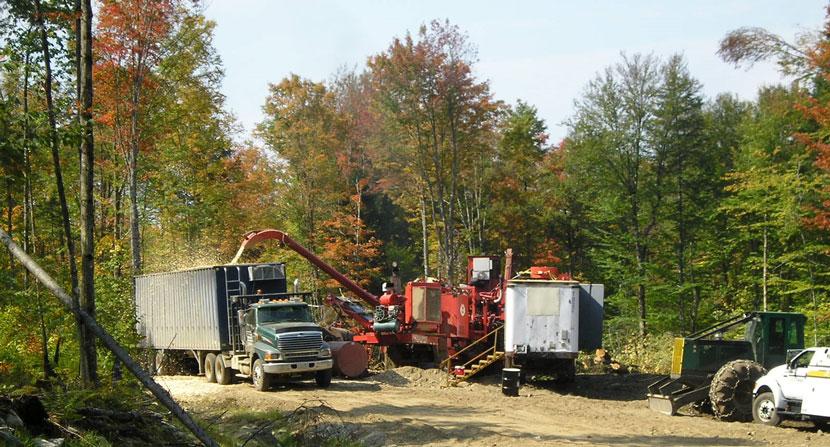
Garland Lumber working on a salvage operation from the 2008 tornado that cleared a 50-mile path from Deerfield to Freedom, New Hampshire. (Photo: courtesy Hunter Carbee)
The sustainable management of forests for wood products is a significant part of the Forest Society’s purpose for owning and managing conservation land. The Forest Society supports public policy initiatives which promote the wise use of forests for building construction, furniture, paper and energy including the harvesting of low-grade wood for energy.
Sustainable forest management can and should increase the age and species diversity of our forests, two important indicators of forest resilience. It serves other land management goals, including the diversifying of wildlife habitats, maintenance of biodiversity, promotion of recreational opportunities, and protection of clean water. Increasingly, as the global focus increases on mitigating climate change’s impacts, forests are also being viewed as a way to sequester and store carbon.
Because of these wide-ranging benefits, the Forest Society’s overarching goal is to help keep New Hampshire’s forests as forests.
Our state’s status as the second most forested in the country (according to data from the US Forest Service’s Forest Inventory and Analysis- the FIA) would seem to indicate we are doing a good job meeting that goal.
However, a troubling trend is emerging. The FIA also shows we have lost almost 390,000 acres of forest to other uses since the peak level of 5.1 million acres of forested area in 1970.. The loss of this resource means a reduction in the benefits they provide.
The question becomes: how to stop, or even reverse, this trend? Part of the answer rests with the private owners who hold over 70% of the 4.7 million acres of forestland here. They are key to the long-term stewardship of this resource. They are committed to that goal- a fact highlighted in the 2018 National Woodland Owner Survey by the U.S. Forest Service. It showed the top five reasons they owned their land were:
- To enjoy beauty or scenery
- To protect wildlife habitat
- To protect nature and biologic diversity
- Privacy
- To protect water
They do, however, have expenses such as property taxes. Markets for the wood harvested off their woodlots, if they choose to take that step, provides needed income to help pay the costs related to forest management and ownership responsibilities. Furthermore, strong markets encourage landowners to invest in and steward their forests thereby serving as the foundation for a locally sourced, renewable and sustainable forest-based economy.
As noted by the UNH Cooperative Extension Program, the forest-products industry is the oldest land-based industry in New Hampshire, dating back to 1634. It is also important to the state’s economy. According to the 2020 NH Forest Action Plan (FAP), the forest products industry is responsible for $1.5 billion of direct economic output with about 7,200 direct jobs attributed to this sector and almost 12,000 total jobs supported.
In addition, the FAP notes that forest-based recreation is responsible for approximately $3.1 billion annually to New Hampshire’s economy.
Maintaining the markets for all grades of wood is essential to the practice of sustainable forestry. In order to cut responsibly, forestland owners need to also cut low-value trees to improve the health and value of the forests. If there is no outlet for this “low grade” wood, the long-term health and quality of the forests are placed at risk. On Forest Society land, about seventy percent of the standing timber is “low grade,” meaning it is not suitable for sale as saw logs to a commercial sawmill that makes lumber. When paper mills and biomass energy plants were flourishing in northern New England, much of this low-grade wood was sold these markets. However, they have retracted considerably in recent years.
The Forest Action Plan highlights this trend. It states that during the period between 2000 and 2017, at least 70-80% of the total volume of timber harvested in the state came from lower value products of pulpwood, firewood and biomass. This article from the Fall 2017 edition of Forest Notes provides a more detailed look at how low-grade wood markets help ensure forests stay as forests and the challenges facing family forest owners.
Two of the major end-uses for the low-grade wood chips has been at the biomass electricity plants in New Hampshire and at commercial and institutional buildings who have switched from fossil fuel heat to modern, efficient wood heat. While the biomass power plants have economically struggled in recent years, we are hopeful the use of biomass to meet the heating needs for residents and businesses represents a growing trend.
The Forest Society believes state policy should aim to find new markets for low-grade wood and maintain the current ones. The end result will be to keep forests as forests and the preservation of their ability to provide deep scenic beauty, recreation opportunities, wildlife habitat, clean water and a more diverse economy.
